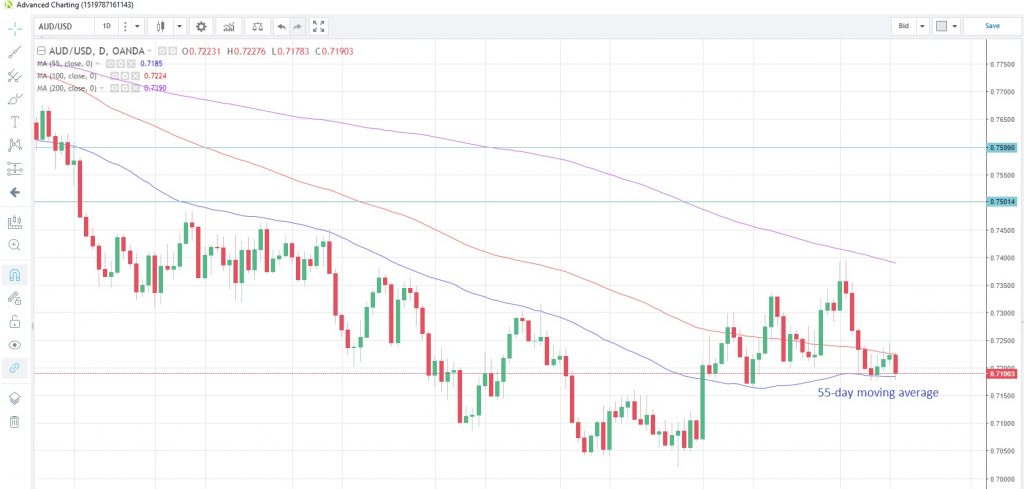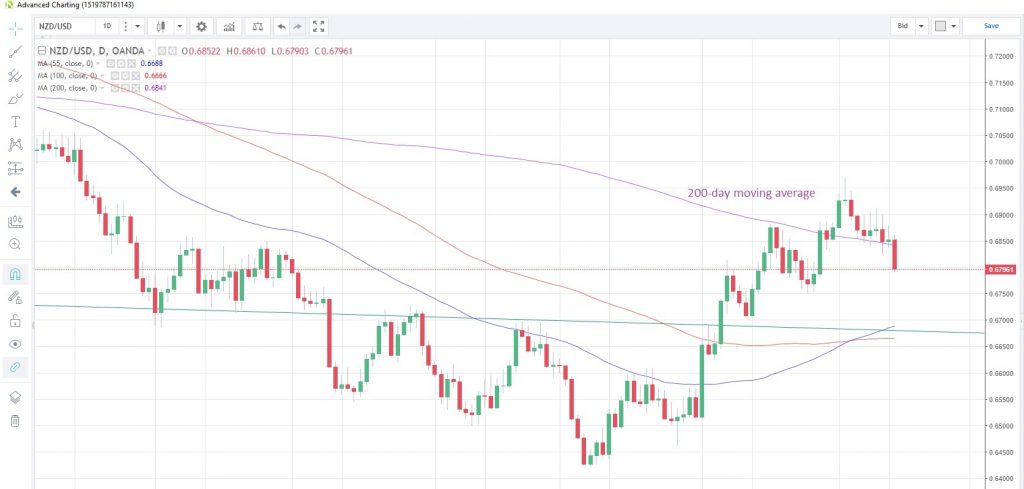Factory output weakest in nearly three years
China’s industrial production slowed significantly in November, rising just 4.4% y/y, the slowest pace of growth since February 2016. Disappointment was not just confined to the manufacturing sector as retail sales also missed estimates. Sales grew 8.1% y/y versus 8.8% forecast. Sales growth has been trending lower for the past two months and is now at the lowest since MarketPulse began collating data in 2010. The only bright spot on the data front today was higher growth in fixed asset investment in November. Investments rose 5.8% y/y, slightly higher than the 5.7% posted in October.
In reaction, the Aussie tumbled as much as 0.62% to 0.7178 versus the US dollar, the lowest since Monday, wiping out three days-worth of gains in one hit. The FX pair is retesting the 55-day moving average at 0.7184, which has held on a closing basis since November 1.
AUD/USD Daily Chart
In comments after the data releases, China’s National Bureau of Statistics acknowledged that the Chinese economy was facing downward pressure, but expects the main economic targets for 2018 to be achieved, specifically GDP growth of about 6.5%. It added that the disappointing industrial production data was impacted by the auto and electronics sectors.
Looking ahead to 2019, the agency said China’s exports, and the economy in general, face uncertainties in 2019. It added that the 2019 growth target should reflect to goal of doubling GDP by 2020 from 2010. Note: 2010 GDP was 41.3 billion yuan with GDP growth of +10.6% y/y. 2017 GDP has been provisionally calculated at 82.7 billion yuan
Kiwi pressured by RBNZ proposals
The New Zealand dollar slumped to its lowest level in more than two weeks after the Reserve Bank of New Zealand announced it was consulting on a proposal to raise the amount of capital local banks must hold in reserve. The proposal includes doubling the required amount of “high quality” capital the banks must hold. NZD/USD fell almost 0.9% to the lowest since November 28, slicing through the 200-day moving average at 0.6841, which had supported prices on a closing basis for the past two weeks.
NZD/USD Daily Chart
PMI data to determine the Euro’s near-term direction
Today sees a number of manufacturing PMIs for December from Markit released. Germany’s reading was at 51.8 last month, the same as the combined Euro-zone’s, and both are expected to improve slightly to 52.0 this month, according to the latest survey of economists. The US version is due later today and is seen edging higher to 55.4 from 55.3.
Another patchy session on Wall Street
Other US data sees November retail sales on tap, which are forecast to slow to +0.2% m/m from +0.8%, while industrial production is expected to tick higher to +0.3% m/m from +0.1%. Echoing this increase, capacity utilization is seen at 78.5% from 78.4%.
The full MarketPulse data calendar is available for viewing at https://www.marketpulse.com/economic-events/
This will be my final MarketPulse update for 2018. Wishing you all a merry Christmas and a happy and profitable 2019.
Content is for general information purposes only. It is not investment advice or a solution to buy or sell securities. Opinions are the authors; not necessarily that of OANDA Business Information & Services, Inc. or any of its affiliates, subsidiaries, officers or directors. If you would like to reproduce or redistribute any of the content found on MarketPulse, an award winning forex, commodities and global indices analysis and news site service produced by OANDA Business Information & Services, Inc., please access the RSS feed or contact us at info@marketpulse.com. Visit https://www.marketpulse.com/ to find out more about the beat of the global markets. © 2023 OANDA Business Information & Services Inc.




